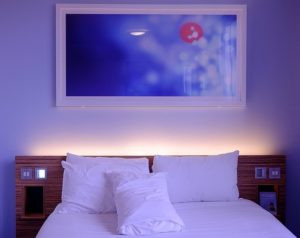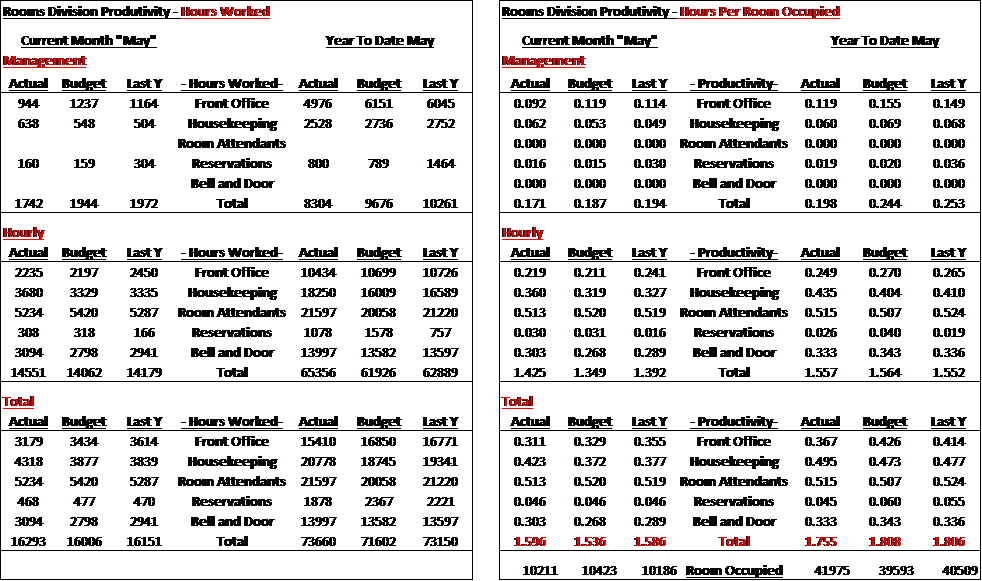Part I – Rooms Productivity
[quotes quote=”“It’s not always that we need to do more but rather that we need to focus on less.” ” citation=”Nathan W. Morris” width=”maxwidth100″ align=”default”] In hospitality, the measurement and management of productivity is hit and miss and miss again. Time and time again hotels are using ineffective measures to try and capture labor productivity measurements.
It is important from the beginning to establish the goals for measuring productivity in your operations. This article will focus on rooms and Part 2 will be F&B.
 The goal in measuring productivity in the rooms division is to see, monitor and ultimately improve on the number of hours of work it takes to service a room. The expression to use is “hours per room occupied.”
The goal in measuring productivity in the rooms division is to see, monitor and ultimately improve on the number of hours of work it takes to service a room. The expression to use is “hours per room occupied.”
Hours worked divided by the number of rooms sold. This labor productivity statistic is the most important tool available to manage your biggest expense in the rooms division.
If you were making cars, you would want to know and continually improve on how many hours and minutes of labor it takes to make a car. Regarding rooms, labor comes down to how many hours it takes to service one room. You want to see this at the total rooms level as well as how it stacks up.
The “rooms stack” is best laid out with the following subtotals: front office, housekeeping, room attendants, reservations and bell/door. These categories must be separate to see where there are productivity wins and challenges. To be able to see labor categories separately, use proper departments and job codes to fall into the different stacks. In addition to the separation of the stacks, you need to know the difference between hourly and management positions in each stack.
To do this effectively and consistently there must be a payroll dictionary. Establishing a consistent way to segregate labor is not difficult. Start by defining the difference between management and hourly positions. For consistency, ignore salaried vs. hourly and union vs. nonunion. These are ignored because they differ greatly from location to location. Instead, focus on job title. The word manager is critical. If the word manager or higher appears in the title, they fall into the management category. If supervisor or a lower title appears in the job title, they fall into the hourly category. Here is an example for “front office.” It is important to recognize that management or hourly terminology is only a way to organize data and is not an indication of any regard.
Front Office Stack
| “Front Office Hourly” – Front Office Clerks, Reception Clerks, Front Office Cashiers, Front Office Supervisor, Reception Supervisors, Night Audit Clerks, Secretary, Admin Assistant | “Front Office Management” – Front Office Manager, Reception Manager, Assistant Manager, Front Office Director, Rooms Division Director, Night Manager & Assistant Night Mgr. |
Repeat the same exercise and organize rooms department and positions into the different stacks and by the “hourly and management” classifications.
Once the classifications are established, track the hours worked in each stack. In turn, divide the hours worked in each stack by the total number of rooms sold for the entire hotel: for 1 day, 1 month or 1 year. Anytime you can capture the number of units of labor (hours of labor) it takes to sell the rooms and divide this by the number of units sold, you have rock-solid data.
The “hours per room occupied” measurement can be used everywhere. Starting with the annual budget. You will want to know the “hours per room occupied for the year” goal. If the total hours for the rooms division in the budget are 45,978 and the total number of rooms occupied in the budget is 37,525 then the hours per rooms occupied is (45,978 / 31,525 = 1.4585). This number 1.4585 is gold!
In everything you do with rooms labor, you now know the measure of success. Meet or beat the productivity goal of 1.4585 hours per room occupied and you win. If you can use this target in your daily schedule, weekly schedule and monthly forecast you can continually adjust the course to track to your target. It is a simple and effective way to track to the goal.
As the operations manager, you cannot have any effect over pricing or wages; they are out of your control. Any measurement that looks at labor as a percentage of sales in noteworthy but you cannot control it. As the operations manager, what you have control over is the schedule and hitting the productivity target if sales volume is down or up. The hours per room occupied is your speedometer and you can tell what stacks are up to speed or not and see if it is an hourly or management issue.
The chart below looks at a monthly and year-to-date report for the rooms division:

Note that all classifications do not have management positions. In the example above, room attendants and bell/door do not have any management positions.
When you measure and track productivity this way you give leaders and managers on the ground a simple and effective tool. There will be days when you lose big on productivity goals. Days like Mondays in a leisure hotel. Challenging productivity days are heavy arrival or departure days, multiple occupancy, and low occupancy. On the other side of the coin, you will have days where productivity is naturally high: stay overs, long stay guests, business travelers, groups with heavy programs, and single occupancy guests.
What operations managers need to see is the hours per room occupied goal. Knowing there will be losses and wins in the days and weeks is natural. Hitting or beating the monthly productivity target is the magic result for them to see and get excited about. https://hotelfinancialcoach.com//hotelfinancialcoach.com//online.purdue.edu/htm/masters-in-hospitality-management/courses Hours per room occupied is the only productivity measure they need to focus on. Get each manager in the rooms division to do their monthly forecast, weekly schedule and daily log all referencing their productivity target and the actual result. Like tacking on a sailing ship, you are constantly moving from a loss to a win and a win to a loss all the time keeping an eye on the desired final destination. Use hours per room occupied in addition to the number of arrivals and departures and room credits on your schedules.
If you are interested in how you can set this productivity measurement in your financial statements, email me and request my article on “Do Your Hotel Financial Statements Pass the Test?” or visit my website, blog page. Having these measurements in your finical statements is critical.
If you would like a copy of any of the following send me an email.
- Hotel Financial Policy Manual – Inventory of “Sections”
- Hotel Financial Coach “Services Sheet”
- EFTE and Productivity Exercise
- White Paper – Hotel Accounting Policy Manuals
- F&B Productivity Spreadsheet
- Rooms Productivity Spreadsheet
- Financial Leadership Recipe F TAR W
- Hotel Financial Coach – “Speaking Sheet”
- Flow Thru Cheat Sheet – Enhanced
Visit my website today for a copy of my FREE guidebook
The Seven Secrets to Create a Financially Engaged Leadership Team in Your Hotel
Call or write today and arrange for a complimentary discussion on how
you can create more profits in your hotel.
Do you need a dynamic speaker with a unique and creative financial message for your next hospitality event?
Are you thinking about your leadership team and what to engage them with this year? Consider a full or half day hospitality financial leadership workshop.
Give the coach a call and let’s get going!
Contact David at (415) 696-9593
